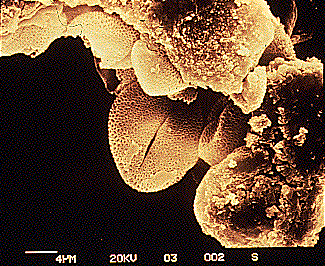Scattered across the sea
the fossilised fingerprints
of your invisible touch
proclaim the coincidence
of our lineage.
A single point from which
we all emerged,
negative imprints
flowing into flesh
then bone.
Seeking to make
a connection
we search through
geological albums
for sepia-tinged memories
of when we first met.
Fabricated processes
of distant time and loss
unearth uneasy truths:
no ancestor of complex life,
just the chameleonic breath
of a common imposter.

This poem is inspired by recent research (two studies: here and here), which has found that molecular fossils extracted from 635-million-year-old rocks aren’t the earliest evidence of complex life on Earth but are instead nothing more than common algae.
From the fossil records, scientists are fairly certain that eukaryotic cells (i.e. cells whose DNA is contained within a membrane-bound nucleus, and of which all animals are composed) first emerged around 1.6 billion years ago, evolving from bacteria. However, the same fossil records show that it wasn’t until almost a billion years later that these cells began to form more complex forms of animal life. By tracking how fast the genetic code is evolving, it is estimated that the last common ancestor of all animals evolved around 900-635 million years ago. What makes things complicated in trying to find evidence of the earliest form of complex life is that these organisms had bodies that were made entirely of soft parts, meaning that they only exist as trace fossils, i.e. negative impressions in rock outlining their bodies. Scientists have thus used other methods to identify biological remains, such as looking at ‘molecular fossils’, i.e. molecules that must have been created by a living creature, and which can be linked back to specific groups of organisms.
In 2010, scientists discovered the molecular fossils of an animal steroid in rocks that were once at the bottom of an ancient sea in the Middle East. Sponges are the only known living organisms that can produce this steroid, and since then similar molecular fossils have been found in seas across the world. One thing that has always troubled researchers however, was how could these sponges have been so abundant, yet leave no trace fossils or negative imprints? In this new study, researchers noticed that the molecules previously linked to sponges looked identical to other molecules that had been formed when algae sediments were converted into rock via naturally occurring geological processes. In order to test this theory, researchers from a complementary study took modern algae and simulated these geological conditions in the lab. They found that they were able to produce the exact same molecules that had been thought to come from ancient sponges – thus showing that chemical processes can mimic biology and demonstrating that these types of molecular fossils can no longer be used as a diagnostic marker for early sponges. With these molecular markers being overturned, the next oldest evidence for animals on Earth are the trace fossils of Dickinsonia, a soft-bodied animal which lived in the oceans approximately 558 million years ago.
Discover more from The Poetry of Science
Subscribe to get the latest posts sent to your email.
Nice poem, Sam.
Thank you Adam. 😊
“chameleonic breath” – Well done, Adam!
Thank you David. 😀
chameleonic breath?
(… smells like flies.)
Very good. 😂